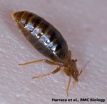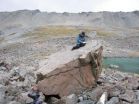(Press-News.org) Male bedbugs are known to be very unfussy when it comes to mating, mounting any well-fed bug they can see - regardless of age or gender. Researchers writing in the open access journal BMC Biology have discovered how immature bedbug nymphs, who would be harmed by the traumatic insemination technique practiced by the males, release alarm pheromones to deter this unwanted attention.
Vincent Harraca, from Lund University, Sweden, worked with a team of researchers to stage encounters between males and females or nymphs. He said, "The chemical communication, as well as the mating behavior, of bed bugs has received increased attention in recent years as bed bug infestations have increased worldwide. Mating is exclusively traumatic, with the male piercing an opening in the female and ejaculating directly into the abdominal cavity. In order to avoid this, we've found that bedbug nymphs release aldehyde pheromones that let the male know that they should look elsewhere. These results may be applied to decrease bed bug populations by mating disruption".
Harraca and his colleagues prevented a group of nymphs from signaling by blocking their scent glands with nail polish. These 'silenced' nymphs were then found to experience the same percentage of mating with sperm transfer as a normal female. Furthermore, application of the pheromones, to a male/female pair during mounting initiation caused a decrease in mating frequency. The anti-aphrodisiac blend of aldehydes was shown to signal through olfactory receptor neurons in the antennae of the repelled males. This research provides new insights into the chemical communication system of bed bugs and challenges the common view that alarm pheromones are used as a predator defense mechanism only.
Speaking about the results, Harraca said, "The chemical communication system of the bed bugs is only just unfolding, and further analyses on longevity costs to nymphs as well as males who have been pierced is a high priority to fully understand the picture of traumatic insemination".
INFORMATION:
Notes to Editors
1. Nymphs of the common bed bug (Cimex lectularius) produce anti-aphrodisiac defence against conspecific males
Vincent Harraca, Camilla Ryne and Rickard Ignell
BMC Biology (in press)
During embargo, article available here: http://www.biomedcentral.com/imedia/1400445407406191_article.pdf?random=824633
After the embargo, article available at the journal website: http://www.biomedcentral.com/bmcbiol/
Please name the journal in any story you write. If you are writing for the web, please link to the article. All articles are available free of charge, according to BioMed Central's open access policy.
Article citation and URL available on request at press@biomedcentral.com on the day of publication.
2. Images of bedbugs are available on request.
3. BMC Biology is the flagship biology journal of the BMC series, now incorporating Journal of Biology, the premier biology journal of BioMed Central, and publishes peer-reviewed research and methodology articles of special importance and broad interest in any area of biology and biomedical sciences, as well as full reviews, opinion pieces, commentary and Q&As on topics of special or topical interest. BMC Biology (ISSN 1741-7007) is covered by PubMed, MEDLINE, BIOSIS, CAS, EMBASE, Scopus, Zoological Record, CABI, Thomson Reuters (ISI) and Google Scholar.
4. BioMed Central (http://www.biomedcentral.com/) is an STM (Science, Technology and Medicine) publisher which has pioneered the open access publishing model. All peer-reviewed research articles published by BioMed Central are made immediately and freely accessible online, and are licensed to allow redistribution and reuse. BioMed Central is part of Springer Science+Business Media, a leading global publisher in the STM sector.
Anti-aphrodisiac protects young bedbugs
2010-09-09
ELSE PRESS RELEASES FROM THIS DATE:
Scots Pine shows its continental roots
2010-09-09
By studying similarities in the genes of Scots Pine trees, scientists have shown that the iconic pine forests of Highland Scotland still carry the traces of the ancestors that colonised Britain after the end of the last Ice Age, harbouring genetic variation that could help regenerate future populations, according to new results published in the journal Heredity.
The research was carried out by an international team from the Centre for Ecology & Hydrology, the Polish Academy of Sciences, the University of Edinburgh and the Macaulay Land Use Research Institute.
Today's ...
Study adds new clue to how last ice age ended
2010-09-09
As the last ice age was ending, about 13,000 years ago, a final blast of cold hit Europe, and for a thousand years or more, it felt like the ice age had returned. But oddly, despite bitter cold winters in the north, Antarctica was heating up. For the two decades since ice core records revealed that Europe was cooling at the same time Antarctica was warming over this thousand-year period, scientists have looked for an explanation.
A new study in Nature brings them a step closer by establishing that New Zealand was also warming, indicating that the deep freeze up north, ...
Investigating better endpoints for immunotherapy trials
2010-09-09
Cancer immunotherapy calls for revised clinical endpoints that differ from those used for chemotherapy, according to an article published online September 8 in The Journal of the National Cancer Institute.
Unlike chemotherapy, which acts directly on tumors, cancer immunotherapies exert their effects on the immune system, which may delay or change response patterns, perhaps owing to the dynamics of the immune system itself. For example, initial tumor burden may increase due to lymphocytic infiltration, because of T-cell proliferation, which is followed by lymphocyte-induced ...
Researchers identify potential new drug for neurodegenerative disease
2010-09-09
BOSTON, Mass. (September 8, 2010)‹Scientists have discovered a small
molecule that helps human cells get rid of the misfolded, disfigured
proteins implicated in Alzheimer¹s disease and other neurodegenerative
ailments. This potential drug could have applications for other conditions
as well.
Cells create and discard proteins continuously, a process that relies on a
balance between the speed with which new proteins are created and damaged
ones destroyed. Protein destruction occurs through a sophisticated system
that marks proteins for disposal by tagging them with ...
New study suggests changes in diagnosis and treatment of malaria
2010-09-09
LA JOLLA, CA - September 7, 2010 –A team of scientists from The Scripps Research Institute, the Genomics Institute of the Novartis Research Foundation (GNF), and the U. S. Naval Research Detachment in Peru has completed a study that could improve the efficacy of diagnosis and treatment strategies for drug-resistant malaria.
In the new study—published online on September 9, 2010 by the journal Genome Research—the scientists analyzed the genomic features of a population of malaria parasites in Peru, identifying the genetic basis for resistance to a common antibiotic.
Malaria ...
NIST researchers hear puzzling new physics from graphene quartet's quantum harmonies
2010-09-09
GAITHERSBURG, Md. – Using a one-of-a-kind instrument designed and built at the National Institute of Standards and Technology (NIST), an international team of researchers have "unveiled" a quartet of graphene's electron states and discovered that electrons in graphene can split up into an unexpected and tantalizing set of energy levels when exposed to extremely low temperatures and extremely high magnetic fields. Published in this week's issue of Nature,* the new research raises several intriguing questions about the fundamental physics of this exciting material and reveals ...
New sickle cell screening program for college athletes comes with serious pitfalls, experts say
2010-09-09
The Johns Hopkins Children's Center top pediatrician is urging a "rethink" of a new sickle cell screening program, calling it an enlightened but somewhat rushed step toward improving the health of young people who carry the sickle cell mutation.
Beginning this fall, all Division I college athletes will undergo mandatory screening for the sickle cell trait. The program, rolled out by the National Collegiate Athletic Association (NCAA), is an attempt to prevent rare but often-lethal complications triggered by intense exercise in those who carry the genetic mutation yet ...
Liver defect likely cause of DHA deficiency in Alzheimer's patients, UCI study finds
2010-09-09
Irvine, Calif. — UC Irvine researchers have discovered that markedly depleted amounts of an omega-3 fatty acid in brain tissue samples from Alzheimer's patients may be due to the liver's inability to produce the complex fat, also contained in fish-oil supplements.
Low levels of docosahexaenoic acid, or DHA, have been associated with the chronic neurodegenerative disease affecting millions of Americans, but no cause had been identified.
In postmortem liver tissue from Alzheimer's patients, the UCI team found a defect in the organ's ability to make DHA from shorter molecules ...
The Economics of Ecosystems and Biodiversity (TEEB) Local and Regional Policy Makers report launched at major biodiversity conference in Ghent
2010-09-09
Ghent, 9 September 2010 – Factoring the planet's multi-trillion dollar ecosystem services into policy-making can help save cities and regional authorities money while boosting the local economy, enhancing quality of life, securing livelihoods and generating employment.
This is the finding from a major international study, launched in a report by TEEB for Local and Regional Policy Makers, being released in Belgium, Brazil, India, Japan and South Africa.
In the Framework of the Belgian Presidency of the European Union, the Flemish Ministry of Environment, Nature and ...
Unauthorized population would soar if birthright citizenship repealed
2010-09-09
University Park, Pa. -- Repeal of birthright citizenship for the U.S.-born children of unauthorized immigrants would expand the nation's unauthorized population by at least 5 million over the next decade, according to a new report from the Migration Policy Institute.
The report's principal author is Jennifer Van Hook, professor of sociology and demographics at Penn State and non-resident fellow at the Washington, D.C.-based institute.
"While some are discussing an end to birthright citizenship as a means to reduce illegal immigration," Van Hook said, "repeal of birthright ...



